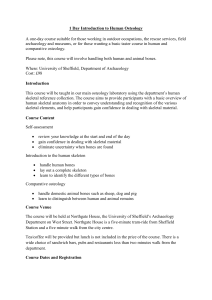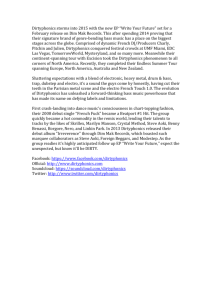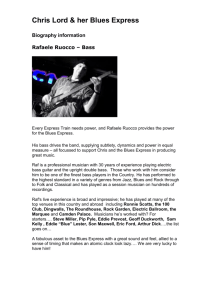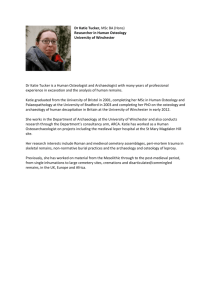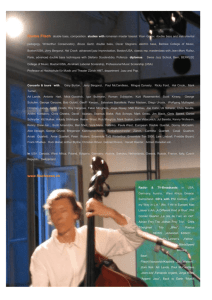human osteology
advertisement
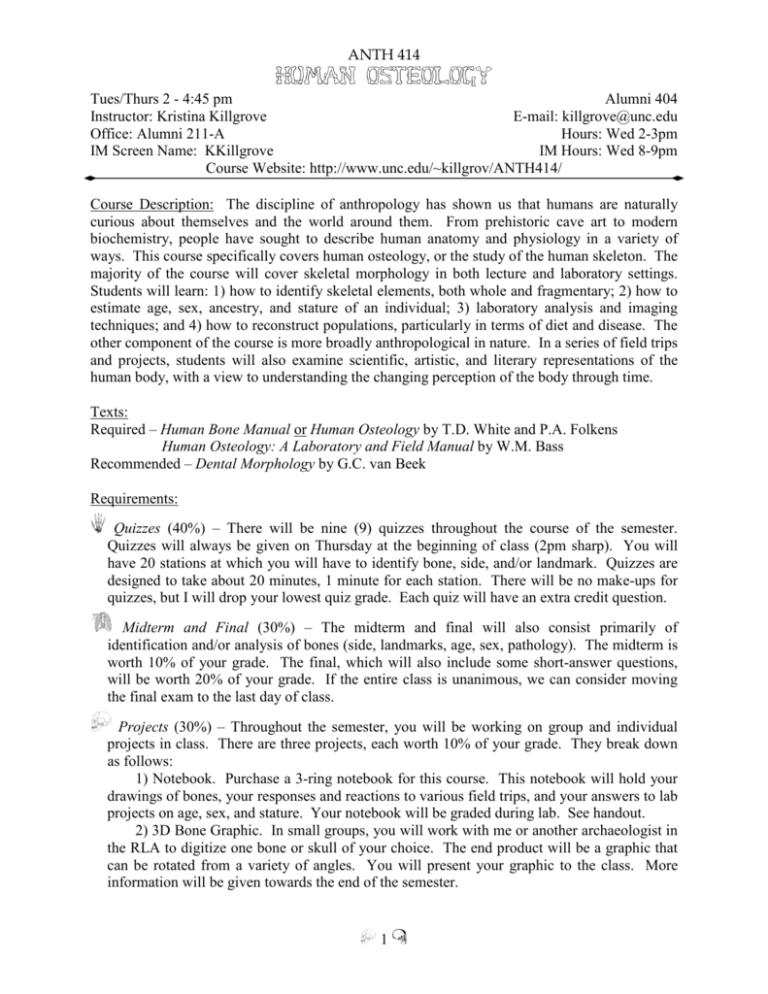
ANTH 414 HUMAN OSTEOLOGY Tues/Thurs 2 - 4:45 pm Alumni 404 Instructor: Kristina Killgrove E-mail: killgrove@unc.edu Office: Alumni 211-A Hours: Wed 2-3pm IM Screen Name: KKillgrove IM Hours: Wed 8-9pm Course Website: http://www.unc.edu/~killgrov/ANTH414/ Course Description: The discipline of anthropology has shown us that humans are naturally curious about themselves and the world around them. From prehistoric cave art to modern biochemistry, people have sought to describe human anatomy and physiology in a variety of ways. This course specifically covers human osteology, or the study of the human skeleton. The majority of the course will cover skeletal morphology in both lecture and laboratory settings. Students will learn: 1) how to identify skeletal elements, both whole and fragmentary; 2) how to estimate age, sex, ancestry, and stature of an individual; 3) laboratory analysis and imaging techniques; and 4) how to reconstruct populations, particularly in terms of diet and disease. The other component of the course is more broadly anthropological in nature. In a series of field trips and projects, students will also examine scientific, artistic, and literary representations of the human body, with a view to understanding the changing perception of the body through time. Texts: Required – Human Bone Manual or Human Osteology by T.D. White and P.A. Folkens Human Osteology: A Laboratory and Field Manual by W.M. Bass Recommended – Dental Morphology by G.C. van Beek Requirements: F Quizzes (40%) – There will be nine (9) quizzes throughout the course of the semester. Quizzes will always be given on Thursday at the beginning of class (2pm sharp). You will have 20 stations at which you will have to identify bone, side, and/or landmark. Quizzes are designed to take about 20 minutes, 1 minute for each station. There will be no make-ups for quizzes, but I will drop your lowest quiz grade. Each quiz will have an extra credit question. K Midterm and Final (30%) – The midterm and final will also consist primarily of identification and/or analysis of bones (side, landmarks, age, sex, pathology). The midterm is worth 10% of your grade. The final, which will also include some short-answer questions, will be worth 20% of your grade. If the entire class is unanimous, we can consider moving the final exam to the last day of class. Y Projects (30%) – Throughout the semester, you will be working on group and individual projects in class. There are three projects, each worth 10% of your grade. They break down as follows: 1) Notebook. Purchase a 3-ring notebook for this course. This notebook will hold your drawings of bones, your responses and reactions to various field trips, and your answers to lab projects on age, sex, and stature. Your notebook will be graded during lab. See handout. 2) 3D Bone Graphic. In small groups, you will work with me or another archaeologist in the RLA to digitize one bone or skull of your choice. The end product will be a graphic that can be rotated from a variety of angles. You will present your graphic to the class. More information will be given towards the end of the semester. Y1Z 3) Skeletal Analysis. Individually, you will work with a skeleton different from the one you were assigned at the beginning of the semester. In a 5-page (approx.) report, you will identify the bones present and report on the skeleton’s age, sex, stature, and pathological conditions. More information will be given after the midterm. In addition to the above, you are required to register for lab and to attend at least one hour of lab each week, on either Tuesday or Thursday after lecture. You will find during the semester that you need more than one hour of lab in order to study or work on your projects. Lab will be open from at least 3:15 until 4:30 on Tuesday and Thursday. If at least four students wish to attend lab on Wednesday, this can be arranged on a per-week basis. Attendance is required at lecture, lab, and field trips. More than two unexcused absences will result in a lower course grade. Course Outline: Date Topic Reading/Assignments Due UNIT 1 Introduction to Osteology 8/24 What is Human Osteology? Course Guidelines White Ch. 1 8/29 Structure of Bone, Laboratory Rules Skeletal Terminology White Chs. 4 & 6 Bass Ch. 1 (pp. 1-8) UNIT 2 8/31 The Human Skeleton Cranium, Skeleton Assignments White Ch. 7, Bass Ch. 2 (pp. 31-61) 9/5 Cranium and Articulated Teeth Bass p. 273 (diagram of teeth) 9/7 Field Trip to Rare Books Collection QUIZ 1 – Cranium and Teeth 9/12 Vertebral Column White Ch. 9, Bass Ch. 3 (pp. 91-105) 9/14 Ethics in Osteology QUIZ 2 – Vertebral Column Deloria article, White Ch. 3, NAGPRA, AAPA statement on race 9/19 Pelvis White Ch. 14, Bass Ch. 3 (pp. 106-9, 192-8) 9/21 Field Trip to Ackland QUIZ 3 – Pelvis 9/26 Shoulder Girdle, Thoracic Cavity White Chs. 10 & 11, Bass Ch. 3 (pp.110-144) 9/28 Arms QUIZ 4 – Thoracic Cavity, Shoulder Girdle White Ch. 12, Bass Ch. 3 (pp. 144-175) 10/3 Hands White Ch. 13, Bass Ch. 3 (pp. 175-192) 10/5 Legs QUIZ 5 – Arms and Hands White Ch. 15, Bass Ch. 3 (pp. 218-258) Sat - 10/7 Field Trip to Dr. Moray’s Office Y2Z 10/10 Feet White Ch. 16, Bass Ch. 3 (pp. 258-270) 10/12 Animal Bones Bass Ch. 5 10/17 Midterm MIDTERM – Includes Legs and Feet 10/19 NO CLASS – Fall Break 10/24 Adult Dentition White Ch. 8, Bass Ch. 4, van Beek Section 2 10/26 Subadult Dentition QUIZ 6 – Adult Dentition van Beek Section 1 UNIT 3 10/31 Identifying Individuals Cranial Landmarks and Measurements 11/2 Adult Sex Estimation QUIZ 7 – Subadult Dentition Bass Ch. 1 (pp. 19-21), White Ch. 19 (pp. 385-397) 11/7 Adult Age Estimation Bass Ch. 1 (pp. 12-19), White Ch. 19 (pp. 363-384) 11/9 Laboratory Recording Techniques 3D Bone project QUIZ 8 – All Bones White Ch. 18 11/14 Postcranial Measurements and Stature White Ch. 19 (pp. 398-9), Bass Ch. 1 (pp. 21-28) UNIT 4 11/16 Population Thinking Reconstructing Diet and Disease 11/21 Field Trip to Isotope Lab (tentative) 11/23 QUIZ 9 – All Bones White Ch. 17; skim White Ch. 5 Schoeninger 1995 NO CLASS – Thanksgiving UNIT 5 11/28 Presentations and Projects Presentation of 3D Bone projects 11/30 Work on projects 12/5 Work on projects 12/11 Bass Ch. 2 (pp. 63-92) FINAL EXAM – 4pm Y3Z Skeletal Identification Project Due Bibliography Additional Required Readings: (online and on reserve in 404) American Association of Physical Anthropologists 1996. “AAPA statement on biological aspects of race.” American Journal of Physical Anthropology 101:569-70. Deloria, Vine Jr. 1992. “Indians, archaeologists, and the future.” American Antiquity 57(4):595-8. Native American Graves Protection and Repatriation Act (NAGPRA) 1990. Schoeninger, MJ. 1995. “Stable isotope studies in human evolution.” Evolutionary Anthropology 4:83-98. Books on Reserve at the UL: (for projects and further information) Aufderheide, AC and C Rodríguez-Martín. 1998. The Cambridge Encyclopedia of Human Paleopathology. Cambridge University Press. Baker, BJ, TL Dupras, and MW Tocheri. 2005. The Osteology of Children and Infants. Texas A&M University Press. Bass, WM. 1987. Human Osteology: A Laboratory and Field Manual. Missouri Archaeological Society. Cox, M and S Mays. 2000. Human Osteology in Archaeology and Forensic Science. Greenwich Medical Media, Ltd. Grauer, AL and P Stuart-Macadam. 1998. Sex and Gender in Paleopathological Perspective. Cambridge University Press. İşcan, MY and KAR Kennedy. 1989. Reconstruction of Life from the Skeleton. Wiley-Liss. Katzenberg, MA and SR Saunders. 2000. Biological Anthropology of the Human Skeleton. Wiley. Larsen, CS. 1997. Bioarchaeology: Interpreting Behavior from the Human Skeleton. Cambridge University Press. Mays, S. 1998. The Archaeology of Human Bones. Routledge. Parker Pearson, M. 1999. The Archaeology of Death and Burial. Texas A&M University Press. Reichs, K, ed. 1986. Forensic Osteology: Advances in the Identification of Human Remains. Thomas. Ubelaker, DH. 1989. Human Skeletal Remains: Excavation, Analysis, Interpretation. Taraxacum. White, TD and PA Folkens. 2000. Human Osteology, 2nd Edition. Academic Press. White, TD and PA Folkens. 2005. The Human Bone Manual. Academic Press. Y4Z
